Disruptive Technology Changes: Great Progress or Failed Promise?
“The secret of change is to focus all of your energy, not on fighting the old, but on building the new.”
Socrates (470 – 399 BC), was a philosopher in ancient Greece, generally credited as one of the founding fathers of western philosophy and renowned for his contribution to the field of ethics.

Image by Edwin Lee
We all know that technology change is rampant – new office systems, social media, consumer marketplaces. It’s not really a question of IF the technology you use today will change, but WHEN. Why do some of these technology changes captivate us while others struggle to attract users?
When systems change, it’s easy to focus on the technology (or even the related process or policy) that is in transition. Most organizations develop new procedures, write communications, and provide training so that people know what to do. These are all important steps. However in order to answer the question of what makes system change “stick”, it’s also vital to consider the role that behaviors and relationships play in preparing for the new beginning.
Recently, we were implementing a new intranet that would introduce enterprise social networking. To be sure the business reasons were clear, we had to move beyond technology design and process definition, to more deeply examine the behaviors we wanted to stimulate and the relationships the system should enhance. We asked our communicators to consider which existing messages would benefit from using a social channel to stimulate two-way communication. This allowed them to re-direct their work rather than add to it which minimized the impact on current staffing models and also elicited the required behavioral change.
Stimulating successful technology change takes into account behavioral components for the organization, the team, and the individual. At each of these levels, consider the following dimensions to think about behaviors:
- Organizational culture – what overt or covert “rules” govern the organization, and how can you align the technology to values that guide organizational behavior?
- Work team climate – what norms or mindsets drive team activity, and how do these collective impressions influence ways the system can provide benefits?
- Individual needs and values – what do individuals find engaging and satisfying in their jobs, and how might the new system enhance opportunities to expand these activities?
When we worked with our communicators on selecting which messages would move to the new social channels, we found that some communications were still unidirectional rather than two-way. We encouraged leaders to consider where they could increase commitment to an environment of open communications, and strengthen relationships to foster trust and mutual respect.
Stimulating successful technology change relies on relationships across a broad cross-section of the organization to find the right sponsors who can build trust and the influential role models who can help mitigate resistance. Consider the following dimensions to influence relationships:
- Leadership – what is the leadership style, and how will that influence planning for the change?
- Management – who might become a role model for adapting the use of human and material resources to take advantage of the new system?
- Structure – what are the key relationships for decision-making, communication, control, and recognition, and how will this impact adoption of the technology?
While Socrates didn’t witness the technology change that we see today, he certainly had insight about system change and the importance of considering a broad set of dimensions.
As the pace of change increases, it’s more important than ever to implement new systems effectively and to address both the tangible aspects of change such as communications, training, and procedures; and those less tangible aspects such as behavior and relationships.
Actions for when you are:
- Analyzing stakeholder impacts
Consider what behaviors are impacted and how that change fits with the organizational culture. Look for leaders and managers who will model the new behaviors.
- Establishing key messages
Align the new system to organizational and individual values. Focus on these common values as a foundation for the change.
- Documenting processes and developing training
Determine how new features of the system can become part of the new norm without adding new work. Explore what can be left behind or re-allocated.
- Examining resistance
Leverage existing relationships. Set up liaisons to help identify and address concerns early.
- Launching coaching opportunities
Integrate with the existing structure. Meet people where they are before asking them to move to the desired future state.
- Take Aim for Successful Change - September 23, 2014
- Disruptive Technology Changes: Great Progress or Failed Promise? - June 17, 2014
- Warming Up to Motivation During Change - March 12, 2014
- Build T.R.U.S.T to Create a Climate of Community - January 28, 2014






